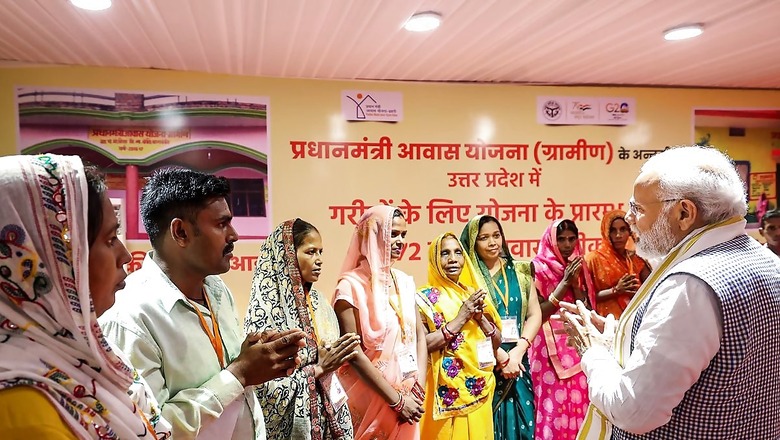
views
This week, India is marking six years since the launch of the Ayushman Bharat Scheme in 2018, when Prime Minister Narendra Modi unveiled his most ambitious health initiative aiming to cover over 50 crore Indians.
Six years on, the Ayushman Bharat scheme has become the world’s largest healthcare insurance programme, covering more people than the population of the United States.
Over 35.5 crore Ayushman cards have been issued under the scheme. And in these six years, more than 7.4 crore Indians have received treatment. Half of these beneficiaries are women.
The scheme’s aim: Deliver affordable healthcare by providing coverage of Rs 5 lakh per family per year for secondary and tertiary hospitalisation. From cancer to bypass surgeries and kidney transplants, this scheme covers over 1,900 procedures, saving countless lives.
Renewed Culture of Health Insurance
While the healthcare insurance industry driven by private players has made strides, it remains a difficult expense for most Indians. Ayushman Bharat has created a culture of health insurance among India’s poor and lower middle-class. Health insurance is no longer a privilege, but a widespread reality, especially for India’s poorest. What’s more, this flagship scheme has actually taken off, and it is delivering in real-time, making more people believe in health insurance than ever. This ultimately aims to prevent them from falling into the debt trap of medical bills.
Saving millions from financial ruin
This isn’t just about healthcare. It’s about combating poverty and preventing financial disasters like medical bankruptcy from wrecking homes. Often, a short hospital visit could financially devastate a poor family in India — and that’s what Ayushman Bharat aims to combat. The World Health Organization estimates that up to 5% of India’s population falls into poverty each year due to healthcare costs. Targeting this problem, Ayushman Bharat has drastically reduced out-of-pocket expenses, saving families from financial ruin. A whopping amount of over Rs 1 lakh crore has already been spent on treatments under the scheme.
Now, which states are seeing the most hospitalisations? The top states under Ayushman Bharat in terms of hospitalisation rates are Tamil Nadu, Karnataka, Rajasthan, Kerala, Andhra Pradesh and Gujarat. Together, these states account for the highest number of treatments. And here’s what’s next. In October, PM Modi is set to roll out a new tier of Ayushman Bharat, covering all Indian senior citizens over the age of 70. This is a huge step towards ensuring affordable healthcare for the elderly, protecting them and their families from the financial burden of medical care.
Challenges Ahead
Several challenges remain however— Odisha, Delhi and West Bengal have still not implemented the scheme over differences with the Centre. Medical bills addressed to the government are piling up in states like Punjab where the state government is struggling to pay its dues. This has led to some hospitals denying treatment for intended beneficiaries. Another challenge is the varying rate of hospitalisation across states. States like Bihar, Uttar Pradesh and Assam have a lot of catching up to do in comparison with their richer peers. With such a massive number of health beneficiaries, improving health infrastructure will be key to the scheme’s success in the future. This also means that the proliferation and enhancement of government hospitals is required other than private hospitals, where most patients prefer to go for serious ailments.
Ayushman Bharat– a Work in Progress
Ayushman Bharat continues to remain a work in progress. Its popularity remains intact even six years after its launch. More people are signing up for it owing to its incredible impact. Ayushman Bharat card issuances have surged, growing by 42 per cent to 35.5 crore as of September 23, compared to the same period last year. Hospitalisations under the scheme have also seen a notable increase of 19.9 per cent during this time.
Government spending on the programme has also increased significantly. For FY25, the government has earmarked Rs 7,300 crore for the scheme, marking a 6 per cent rise over the revised estimates for FY24. Ayushman Bharat isn’t just a health scheme — it’s a lifeline for millions. It’s preventing poverty, ensuring healthcare access for the most vulnerable, and changing the face of healthcare in India. As this scheme continues to grow, it’s not just saving lives, it’s securing futures.
Insuring India’s Health to Secure its Future
Prime Minister Modi has acknowledged that India’s growth as a nation depends fundamentally on the health of its people. A country with poor healthcare infrastructure and inadequate access to medical care cannot truly thrive. This realisation has led to the launch of initiatives such as Fit India and Khelo India, aimed at promoting fitness and sports culture across the country. But the most transformative initiative has been the Ayushman Bharat scheme owing to vast financial commitment to its people that it ties the Indian state with. Moreover, most of his political opposition has also participated extensively in the implementation of the scheme through the states ruled by them. This is about more than just healthcare — it is about nation-building. Poor health without sufficient care can act as a drag, not only on individual lives but on the economy as a whole.
By insuring millions of people under Ayushman Bharat, India is not just addressing immediate health needs, but it’s investing in the nation’s long-term economic prosperity. A healthy population is crucial for a strong workforce, greater productivity and sustained economic growth. In Modi’s vision, by ensuring healthcare for the most vulnerable, India is insuring its own future as a Viksit Bharat — a developed, prosperous nation.

















Comments
0 comment